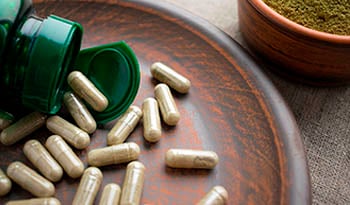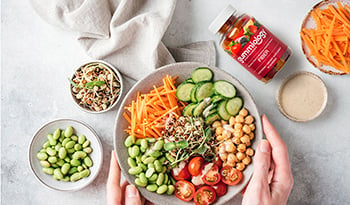The Health Benefits of Dietary Fiber
DISCLAIMER:This blog does not intend to provide diagnosis...

According to the World Health Organization, the typical adult should be consuming about 25 grams of fiber daily. However, most people are not consuming enough.
Fiber is a type of carbohydrate. Most ingested carbohydrates are broken down in our gastrointestinal (GI) tract and then absorbed from the gut into the bloodstream. However, fiber is a component of plants that is not digested or absorbed by the human GI system. It simply passes through our gut and exits in our stool.
Why is it beneficial then if it simply passes through, you may be wondering? Because it adds bulk, creates a softer stool consistency, and aids the transit of stool within our intestines. Prevention of constipation is one of the top reasons people seek a high-fiber diet, and with good reason. Constipation can be uncomfortable–causing abdominal pain, bloating, pain with defecation and straining. It is also the primary cause of hemorrhoids and anal fissures, which are clearly no fun. Dietary fiber is a vital component in preventing all of this.
In addition to maintaining bowel health, however, studies show numerous other potential benefits of dietary fiber:
Diverticulitis
“Diverticula” are tiny out-pouching pockets in the colon and quite common. We refer to this is “diverticulosis.” If small amounts of food particles get “stuck” in these pockets, however, bacteria can infect and inflame these regions–we refer to this as “diverticulitis.” Note that in medicine, anything ending in “-itis” reflects inflammation. And diverticulitis is quite painful, as those who’ve experienced it can attest. Adding bulk through fiber aids in the passage of stool and food particles, creating a smoother ride down the colon and thereby protecting against diverticulitis.
Weight Management
Fiber adds bulk and induces a feeling of prolonged satiety. It protects against overeating, and those who consume a high-fiber diet have decreased risk of developing obesity in their lifetime, and may even experience weight loss.
Heart Disease
Numerous studies (5,6) have suggested that a higher fiber diet is associated with decreased risk of cardiovascular disease, which includes heart disease and stroke. In fact, for each 10g of dietary fiber, the risk of coronary events decreased by 14% and coronary death by 27% for both men and women in one study.
Diabetes
A high-fiber, whole grain diet (particularly with bran and cereal fiber) also decreases the risk of developing diabetes and controls blood glucose levels in diabetics. This may at least partially be due to a lower glycemic index in high-fiber foods.
Cholesterol
Various studies also suggest that soluble fibers can aid in the reduction of total and LDL cholesterol, although the reduction is likely modest. Whole grain oat, in particular, may be the most effective.
Colorectal Cancer
Some expert groups report that consuming a higher fiber diet may be protective against the risk of developing colorectal cancer. However, the data is still conflicting until further research is conducted.
Irritable Bowel Syndrome (IBS)
IBS is an incurable, frustrating condition in which patients experience constipation and/or diarrhea, along with abdominal discomfort triggered by certain foods or stressors. The role of fiber in IBS is currently inconclusive, however, with the data showing mixed results. Fiber can potentially worsen the symptoms of IBS in some, and a large study refuted the effectiveness of fiber in IBS patients. Other studies have found benefit in the use of psyllium in particular to treat IBS. Overall, there is no long-term harm in a trial of fiber for those with IBS–just remember to initiate and increase the quantity gradually into your diet.
Food Sources of Fiber
There are two types in dietary fiber, both with potential health benefits. Soluble fiber (psyllium, oat, pectin, nuts, beans) dissolves in water, and is the type that’s most linked to diminished heart disease and diabetes risks. Insoluble fiber (wheat bran, legumes, brown rice) does not dissolve in water and is best for maintaining bowel health. Obtaining a mix of both types in your diet is preferable.
Tips to Consume More Fiber
- Opt for whole grains (100% whole-wheat bread, brown rice, whole wheat pasta, etc.) rather than refined grains (white bread, white rice, etc.)
- Opt for a serving (or two) of vegetables with each meal.
- Instead of processed, refined sweets, opt for fruit for dessert.
- Instead of juice, opt for the actual fruit.
- Opt for a high-fiber cereal in the mornings, not high-sugar.
- For constipation, consume prunes, which are a fiber source with more of a stool-softening effect.
- Mix a couple of spoons of pure wheat bran to your food.
- It’s best to obtain fiber through the diet. However, if you are unable to and opt for supplementation, be sure to gradually increase your fiber dose through time to mitigate any risk of bloating, cramping and flatulence.
- If you increase fiber, make sure you’re drinking sufficient amount of fluids to match the increase.
References:
- https://health.gov/dietaryguidelines/2015/guidelines/appendix-7
- https://www.ncbi.nlm.nih.gov/pubmed/9521633
- https://academic.oup.com/jn/article/130/2/272S/4686350
- https://www.ncbi.nlm.nih.gov/pubmed?term=21696306
- https://www.ncbi.nlm.nih.gov/pubmed?term=24355537
- https://www.ncbi.nlm.nih.gov/pubmed?term=25727082
- https://www.ncbi.nlm.nih.gov/pubmed?term=14980987
- https://www.ncbi.nlm.nih.gov/pubmed?term=17760498
- https://www.ncbi.nlm.nih.gov/pubmed?term=12197996
- https://www.ncbi.nlm.nih.gov/pubmed?term=9925120
- https://www.ncbi.nlm.nih.gov/pubmed?term=26269373
- https://www.wcrf.org/dietandcancer/exposures/wholegrains-veg-fruit
- https://www.ncbi.nlm.nih.gov/pubmed/9895396
- https://www.ncbi.nlm.nih.gov/pubmed/9521633
- https://www.ncbi.nlm.nih.gov/pubmed?term=21833945
- https://www.ncbi.nlm.nih.gov/pubmed/19713235

 By Dr. Sanaz Majd, M.D.
By Dr. Sanaz Majd, M.D.


